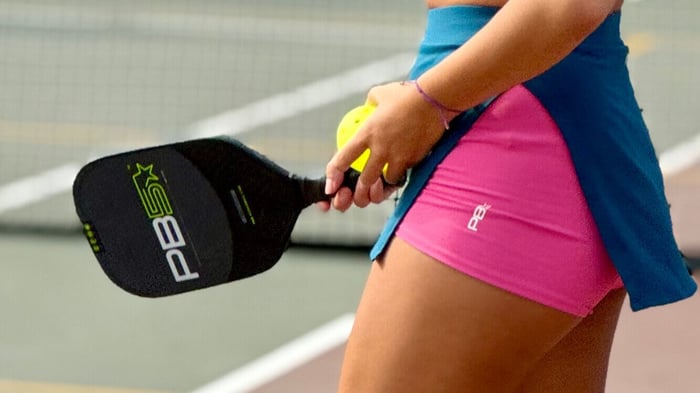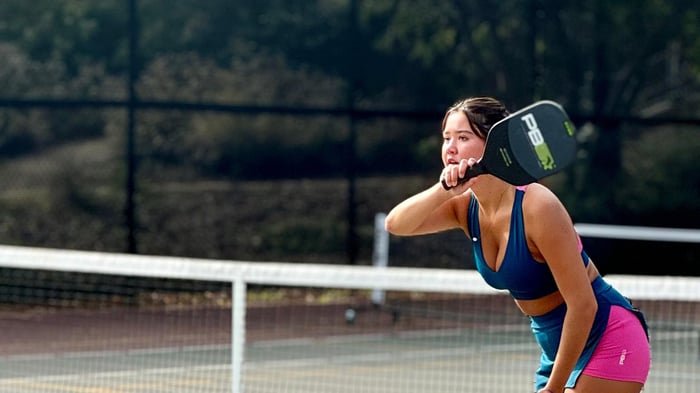Key takeaways:
Use your existing skills—just adapt the mechanics. Your court awareness, footwork, and timing still work in pickleball. Tighten up your swing and get comfortable with softer, more controlled shots.
You don’t need to cover tons of ground—just move efficiently. Get to the kitchen line early, stay balanced, and reset after every shot.
Pickleball-specific paddles, shoes, and apparel make a noticeable difference, especially when the tempo picks up and the rallies get tight.
If you've played tennis, badminton, or squash, you already know how to move on a court, track a ball, and think a few shots ahead. Those instincts don't go away—they just need a little tuning to fit the flow of pickleball.
If you want to know how to transition from other racket sports to pickleball, this guide walks you through how to make the switch without starting from square one. We'll cover what's different, how to adjust your style, and which strategies and gear will help you feel at home on the court. And when you're ready to gear up for the court, PB5star has everything you need to play pickleball comfortably and confidently.
Get familiar with the differences
Pickleball looks familiar, but you'll notice it moves differently once you start playing. The rallies are quick, the space is tight, and the rules ask you to think more strategically from the start. Understanding a few basics upfront will make the learning curve way less steep.
Court size and pace
The pickleball court is smaller at 44 feet by 20 feet, but that means things happen faster. Less space, less time to react. You'll rely more on footwork and positioning than big swings or full-court coverage.
Gameplay structure
The underhand serve and double-bounce rule slow down the opening of each point. Once that's cleared, though, it's all about quick hands and smart decisions at the net—especially with the kitchen cutting off your ability to volley too close.
Different gear, different feel
No strings, no felt ball, just a solid paddle and a plastic ball that doesn’t bounce or spin the way you’re used to. You’ll need to adjust your timing and touch, but once it clicks, the control and finesse start to feel surprisingly natural.
Get these basics down, and you'll spend less time guessing and more time getting into the rhythm of the game. You can also check out this visual breakdown of key differences if you want a side-by-side view.
Rework your technique, not your instincts
You don't need to relearn how to be an athlete—you need to shift how you use your skills. Your reflexes, court sense, and ability to build a point are already there. It's just about making a few mechanical tweaks so they work with the paddle and the pace of play.
Tighten up your swing - Long, loopy strokes don't help here. Keep your paddle in front, stay compact, and focus on simple contact.
Stay low and steady - Paddle up, knees bent, ready to react. Staying grounded gives you the balance you need during fast kitchen exchanges.
Use depth and direction, not just speed - You’re not swinging for winners, you’re building smart combinations that create openings. Hit deep to back them up, then angle short or drop it in soft. Practicing beginner drills are great for building consistency and confidence with those shots.
Watch your opponent's paddle - You'll start reading their next move before they even hit it. That extra second can make all the difference in a quick rally.
Adjust your movement on the court
You're not sprinting baseline to baseline like in tennis, but that doesn't mean you get to stand still. Movement in pickleball is quicker, sharper, and more about efficiency than endurance. You'll win more points by consistently being in the right place at the right time.
A few smart movement habits will make the court feel way more manageable:
Get to the kitchen early
After the serve or return, move up. This is your command center; the sooner you get there, the more control you'll have.
Stay connected in doubles
Don't drift apart. Move laterally with your partner to cut off angles and cover the middle.
Reset after every shot
Don’t just watch your shot—get back into position with your paddle up and feet set.
Once your footwork gets sharper, the rest of your game starts falling into place. Movement isn’t just physical; it’s how you stay in control of the point.
Rethink your serve and return game
If you're used to power serves and aggressive returns, this part might feel underwhelming at first—but in pickleball, it's less about overpowering your opponent and more about starting clean and getting into position.
Serve deep and simple
Keep it legal; keep it deep. That extra space allows you to advance and gets your opponent on their heels.
Return with a plan
You're not trying to hit a winner. You're trying to set up the next shot and give yourself room to move in.
Use that second bounce
The double-bounce rule gives you a beat to reposition. Use it to close the gap and get ready at the kitchen.
The serve and return might not win you the point outright—but they give you a head start on owning the next shot.
Build a smarter pickleball strategy
You don't need to be the fastest or strongest player. You just need to be the one making smarter choices. You'll win points without wasting energy when you play with intention—especially as you get deeper into matches or tournaments.
Don't burn out early - Save your full-effort hustle for when it counts. Efficient movement keeps you fresher for longer.
Own the soft game - Drop shots, resets, and dinks can flip a rally in your favor. The players who win consistently know when to speed it up—and when to slow it down.
Play with purpose - Think a few shots ahead. Hit deep to push them back, then drop one short. Force mistakes instead of forcing the point. A good rule is to place 75% of your shots deep to keep pressure on your opponent and control the tempo.
Take your time between points - Slow your breathing, towel off, and reset. Tempo matters—and you're allowed to control it.
Strategy is your best friend when your body starts to fatigue. It's what keeps your game steady when the pressure builds.
Upgrade your gear for the switch
The apparel you used for tennis or badminton might get you through a casual game, but as you keep playing you'll eventually want equipment that supports the tempo and movement of pickleball. A paddle that fits your grip, shoes that can handle quick lateral steps, and apparel that keeps you cool make a difference.
Balance Paddle - Lightweight and designed for a good mix of power and control—perfect if you're still adjusting your touch and timing.
PB5 Court2 Shoes - Made for side-to-side movement with serious grip. Great support without the bulk.
Core Performance Tee - Breathable, moisture-wicking, and built for hours of movement.
Side-Split Court Dress - Flexible, comfortable, and court-ready.
PB5star Signature Hat - Keeps the sun and sweat out of your eyes so you can focus on your game.
Dialing in your gear makes the transition easier. And it just feels better when your setup works with you—not against you.
Keep building your game
Adjusting to a new sport doesn’t mean leaving your old strengths behind. Pickleball gives you space to use what you already know while sharpening skills you might not have leaned on before. The more you play, the more things click, and the more fun it gets.
Whether you're just getting started or leveling up, PB5star gear is designed to support your game at every stage. Reliable, court-tested, and built for pickleball—you’ll feel the difference from your first rally to your last.







